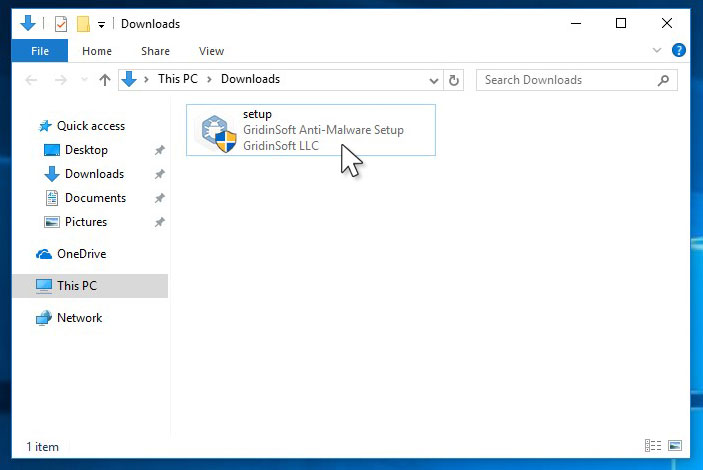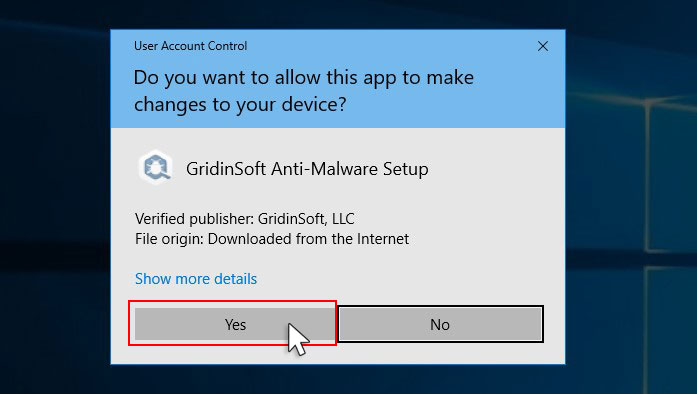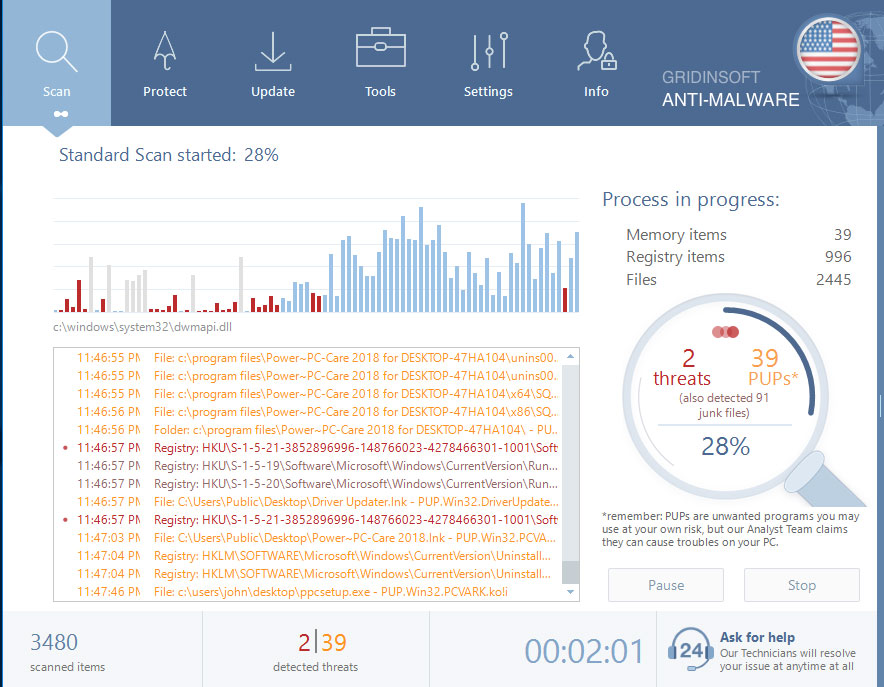Piny Virus Removal Guide (+Decrypt .piny files)
Piny – Ransomware
Piny is a destructive software functioning as common ransomware. Michael Gillespie, the widely known virus researcher, first found this new name in the DJVU ransomware family.
Piny was developed for the sole function to encrypt all popular file types. Rationally, as soon as the file encryption is effectively accomplished, the users are unable to get access to them. Piny virus adds its own “.piny” to all the encrypted data. For example, the file “price_list.xls”, when modified by Piny, will be entitled as “price_list.xls.piny”. As soon as the encryption is achieved, Piny puts its own distinct text file (_readme.txt) into all the folders that store the encrypted files.
The alert stated by text file requesting for the random os very comparable to the alerts given by other ransomware risks belonging to the DJVU family. The caution basically shows that the information has been encrypted and the only service to get access to it is to use a special standalone key. Regretfully, this statement is absolutely real.
The approach to encrypt the files utilized by Piny is not totally looked into. Nevertheless, there is no doubt that each computer system owner may be released a special decryption key, which is definitely unique. It is extremely tough to recover the data without the appropriate type in place.
“Don’t worry, you can return all your files!”, from _readme.txt message:
One more peculiarity of the Piny infection is that the users are unable to get access to the key. The decrypting key is hosted on a special server under the total control by the crooks who have introduced the Piny virus into the internet. In order to acquire the key and restore the important data, the users are informed to get in touch with the frauds via email or by telegram and to pay the ransom in the amount of $980.
The message also states that the people should get in touch with the Piny authors within 72 hours upon the moment of the information file encryption. The alert suggests that by doing so individuals will acquire a 50% discount rate, for that reason, the ransom amount drops down to $490.
Piny modified your information, nevertheless, it might not be the only risk on your computer. Plus, the ransomware may be hidden deep in the system. To detect and erase the risk completely, we advise you to describe the assistance of GridinSoft Anti-Malware .
Download GridinSoft Anti-Malware
GridinSoft Anti-Malware Review, How to get free trial?, EULA, and Privacy Policy.
No matter what the amount of the ransom is, we strongly recommend that you do not pay the ransom. There is no warranty that these online criminals will keep their promises, so they might not care at all what the victims feel about the file encryption, even when the quantity of the ransom is received into their accounts. Thus, paying ransom typically does not lead to an effective recovery. So, the users might simply lose their money for nothing.
Likewise, we prompt you not to get in touch with the frauds as they advise. Do not move loan into their wallets. There are no applications that might crack the Piny ransomware or restore the data at no charge. Therefore, the only correct choice is to restore the data from possible backups (if readily available).
Virus Summary
| Name | Piny Ransomware |
| File Extension | piny |
| Type | Ransomware |
| Family | DJVU |
| Short Description | The ransomware encrypts all the data stored on your system and requires a ransom to be paid on your part supposedly to recover your important files. |
| Symptoms | File encryption by the ransomware is performed by means of the AES-256 algorithm (CFB mode) encryption algorithm. Once the encryption is completed, the ransomware adds its special .piny extension to all the files modified by it. |
| Distribution Method | Adware bundles and software cracks |
| Similar Infections | Peek, Mkos, Nbes |
| Removal Tool | GridinSoft Anti-Malware |
Do not forget that the Web is now loaded with infections similar to the Piny virus. For instance, this particular threat is essentially similar to Brusaf and other ransomware-type infections. These damaging energies have been developed in order to encrypt the essential data and reveal the need for the users to pay the ransom. All these infections use the identical algorithm to produce the specific key for effective information decryption.
Unless the Piny ransomware is still under the advancement process or has actually got some hidden bugs, it is not possible to restore the data manually. Hence, the only working solution to prevent the loss of your crucial data is to frequently keep current backups of all your important data.
Another crucial piece of suggestions is to store the backups on special storage not linked to your primary PC. For instance, you might keep it on the USB Flash Drive, or some external hard disk drive, or by using the cloud data storage services. Keeping the backups on your routine drive is really risky, since the backup may likewise be secured by the Piny .
Leakages for the Piny ransomware attack.
Piny utilizes numerous courses to penetrate the susceptible computers. It is not particular what specific technique was utilized in your case, however, the invasion may occur via the following channels:
- bundling with third-party programs, generally free apps;
- spam e-mails from the unknown senders;
- websites providing free hosting;
- P2P (peer-to-peer) torrent downloads.
There are times when the Piny ransomware may disguise itself as some authentic application, for instance, through the deceptive alerts demanding setup of some software application update. This is the most common technique utilized by the scams to inject the Piny infection files into the system. By doing this users partially take part in its installation, without clearly understanding the danger.
Additionally, the scams might send out unsolicited spam e-mail with difficult signals encouraging individuals to open suspicious attachments or click on some download links, for example, those encouraging the people to open particular pictures, text files, tax documents and other info.
No doubt, opening these files or clicking the harmful links may essentially harm the system. Fake Acrobat Reader update alerts may lead to the Piny ransomware infiltration. Likewise, downloading the split software might in addition include the ransomware installer. The last however not the least, setup of Piny might happen through some Trojan horses that may be installed stealthily into the system and without the user’s direct consent and even consent.
Avoiding the Piny injection.
Of course, there is no absolute assurance that your computer system will be always devoid of any malware attacks, however, we would like to share some useful tips with you to make it safer. Make certain to pay extremely close attention while searching the web and particularly while getting cost-free programs. Do not open any suspicious email attachments, particularly if the sender is not understood to you.
Do not forget that certain freeware installer might likewise include some other extra apps in the bundle. These additional applications might be really harmful. It is of utmost significance to keep your anti-virus software application and your os in basic to be constantly effectively upgraded.
It is rather logical that downloading pirated software is unlawful, nevertheless, in addition, such unapproved programs usage may likewise bring major damage to your PC. Thus, do not download any split programs. Plus, the fact that your present anti-virus did not secure the system from the Piny ransomware is a good factor for you to reconsider your options and switch to another program that can render the protecting functions on a much better level.
Below please find the quotation from the Piny text file:
ATTENTION! Don't worry, you can return all your files! All your files like photos, databases, documents and other important are encrypted with strongest encryption and unique key. The only method of recovering files is to purchase decrypt tool and unique key for you. This software will decrypt all your encrypted files. What guarantees you have? You can send one of your encrypted file from your PC and we decrypt it for free. But we can decrypt only 1 file for free. File must not contain valuable information. You can get and look video overview decrypt tool: https://we.tl/t-2P5WrE5b9f Price of private key and decrypt software is $980. Discount 50% available if you contact us first 72 hours, that's price for you is $490. Please note that you'll never restore your data without payment. Check your e-mail "Spam" or "Junk" folder if you don't get answer more than 6 hours. To get this software you need write on our e-mail: [email protected] Reserve e-mail address to contact us: [email protected] Our Telegram account: @datarestore
Screenshot of files with “.piny” extension added by the ransomware:”

Use GridinSoft Anti-Malware to remove Piny ransomware from your computer
1.Download GridinSoft Anti-Malware.
You can download GridinSoft Anti-Malware by clicking the button below:
2. Double-click on the setup file.
When setup file has finished downloading, double-click on the setup-antimalware-ag.exe file to install GridinSoft Anti-Malware on your computer.

An User Account Control asking you about to allow GridinSoft Anti-Malware to make changes to your device. So, you should click “Yes” to continue with the installation.

3. Press Install button for run GridinSoft Anti-Malware.
3.Once installed, GridinSoft Anti-Malware will automatically run.
4. Wait for the GridinSoft Anti-Malware scan to complete.
GridinSoft Anti-Malware will automatically start scanning your computer for Win Speedup 2018 and other malicious programs. This process can take a 20-30 minutes, so we suggest you periodically check on the status of the scan process.

5. Click on “Clean Now”.
When the scan has completed, you will see the list of infections that GridinSoft Anti-Malware has detected. To remove them click on the “Clean Now” button in right corner.









